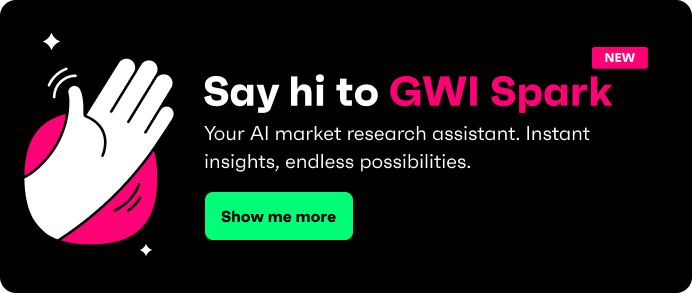
In a world where platforms change by the week and algorithms never sit still, social media strategy can feel like a game of whack-a-mole. The brands that are winning in this space aren’t just watching what audiences do, they’re figuring out why they do it. And that’s where consumer insight steps in.
When you know what really motivates people, you stop chasing trends and start shaping them. Marketers need instant access to real, survey-backed data. So when behaviors shift, your strategy can shift too, without skipping a beat.
What are consumer insights in a social media context?
Think of consumer insights as the story behind the stats. Not just clicks and impressions, but the motivations, values, and moods driving that behavior in the first place. It’s the kind of depth you don’t get from standard social analytics.
Say you’re looking at LinkedIn. You might notice a bump in engagement, but without insight, you won’t know what’s fueling it. Or what you can do to make the most of the opportunity for your brand. But by pairing this with in-depth data on consumer behavior, you can piece together the picture of why you’re seeing this boost, and what your brands can do to capitalize on it.
For example, right now, over a quarter of LinkedIn users have watched a video on the platform in the past month, outpacing the number that’re messaging recruiters. That’s a major shift in how the platform’s being used. Brands that can dig into rock-solid data on what’s behind this change can be ahead of the game when it comes to pivoting their social strategy to talk to their consumers where they’re at, not where brands think they’ll be.
Why audience understanding is now a strategic imperative
Scroll habits have evolved. So have expectations. What started as an entertainment-first experience is now something much broader, especially on platforms like TikTok.
Since Q4 2021, there’s been a 58% rise in TikTok users who turn to it for news, and the same jump applies to those using it for messaging. What that tells us is clear. Platforms are blending roles, and audiences are bringing different intentions to the same space.
To keep up, marketers need to think in real time. Relevance isn’t just about tone or timing anymore. It’s about understanding what people are looking for on social media in the first place.
Platforms like GWI Spark let you pull that kind of intel on demand. That way, you can respond quickly when user behavior shifts, not after the fact.
Turning insight into strategy: Key use cases
This is where the rubber hits the road. Let’s talk about what insight actually unlocks for brands when it comes to putting it in practice.
Firstly, platform strategy gets sharper when you know how consumers are discovering things online. TikTok, for instance, has seen a 71% increase in people using it to find new brands. That’s a green light for any marketer targeting younger, mobile-first audiences. And a great opportunity to create some tailored content that appeals to what these scrollers are looking for.
Secondly, influencer choices become easier when you understand trust dynamics. Our data shows that half of vlog watchers say they trust product review videos. That makes that content type a powerful tool, not just a vanity play. And gives brands a clear direction to go in when it comes to product showcases, influencer and USG marketing.
Next, consumer data allows us to see that formats also evolve with audience expectations. Engagement on Instagram Reels is up 25%. And short-form isn’t so short anymore with TikTok and YouTube Shorts both expanding the length of their videos. You don’t just need to know what to post, but how to keep people watching and coming back. By tapping into insights on behaviours, brands can unlock the answer to those key questions.
Finally, trend prioritization becomes less risky. Threads, for example, is now the fastest-growing social platform across all generations. But why? It’s being driven by demand for news and meaningful communities. That’s the kind of context marketers need to decide whether to jump in early or wait it out.
Each of these examples has one thing in common. The strategy behind them only works when it’s built on solid, behavioral data. That’s what GWI Spark delivers, giving you real-world context, not just surface-level numbers.
Real-world examples of insight-driven social campaigns
Insight helps you show up at the right time, in the right way.
That surge in TikTok brand discovery? Smart marketers clocked it early and shifted focus. Instead of traditional promos, they leaned into explainer content, short stories, and brand narratives that offered real value. It wasn’t just trend-chasing. It was trend-leading.
And over on LinkedIn, the rise of watching video among Millennials and Gen Z is reshaping what professional content looks like. B2B brands are rethinking tone and embracing quick-hit videos that connect on a human level. Not just another talking head.
These aren’t just creative choices. They’re strategic decisions made with insight in hand.
What happens when you don’t use insight?
Without consumer insight, social strategy becomes a game of assumptions.
You might think you're nailing the brief because your analytics look healthy on the surface. But you could still be missing passive users, misreading intent, or pushing content that doesn’t hit the emotional mark. And just because your follow rate looks good, doesn’t mean your content is working for you the way you need it to. These days, metrics like watch time, shares, and saves are much more important to brands when it comes to their tracking.
Let’s take a look at platform fit as an example of where consumer data can change the game. Without insight, it’s easy to assume users on every platform want the same thing: quick videos, trending audio, polished visuals. But the real story looks a lot different. Reddit users value unfiltered authenticity, and TikTok audiences want quick, emotional impact. Treating those spaces the same means missing what actually works, and risks alienating your target audience with the wrong kind of content.
That’s the danger of relying on surface-level data. Consumer insight closes the gap between looking relevant and actually being relevant.
How to build a social strategy using audience data
Building a smarter strategy doesn’t need to be complicated. Here’s how it plays out in practice:
- First, define what you want to achieve. Whether that’s awareness, engagement, or conversion, the goal shapes the lens you look through.
- Then, open up GWI Spark. Use it to understand audience behavior on each platform, what formats they respond to, and how attitudes shift by generation or location.
- Once you’ve got that, align creative and messaging with the insight. Build content that fits the platform, reflects the audience, and ladders up to your goals.
- Finally, keep optimizing. Social isn’t a one-and-done. The best campaigns adapt as they go, powered by a constant stream of fresh insight.
A great example? Live streaming. It’s taken off in APAC and is now gaining traction in the US with nearly 2 in 5 TikTok users in the US having watched a livestream in the past month. That’s a trend worth testing. And you wouldn’t have known about it without access to consumer insights.
The future of social strategy: AI and consumer insights working together
AI isn’t just another tool in the stack. It’s becoming part of how marketing happens. But not all AI is built the same.
Plenty of platforms pull from random online content, and aren't always the most trustworthy when it comes to sourcing data. GWI Spark is powered by survey data from real people. That’s a big deal. Because when you’re making decisions that shape creative, spend, or strategy, you need answers you can trust. Not hunches dressed up as facts.
As audience expectations evolve, brands need insight that’s timely, tailored, and true. AI that delivers that kind of clarity? That’s the kind worth betting on.
Final thoughts: Data is your competitive advantage on social
Relevance isn’t a trend. It’s the goal. And you don’t get there by guessing.
Consumer insight gives you the edge. It shows you what people care about, how they behave, and what will actually resonate. With tools like GWI Spark, teams can turn real, trusted data into action - building campaigns that don’t just perform, but connect.





.webp?width=495&height=317&name=pink_thumb_graphs%20(1).webp)
.webp?width=495&height=317&name=pink_thumb_letter%20(2).webp)